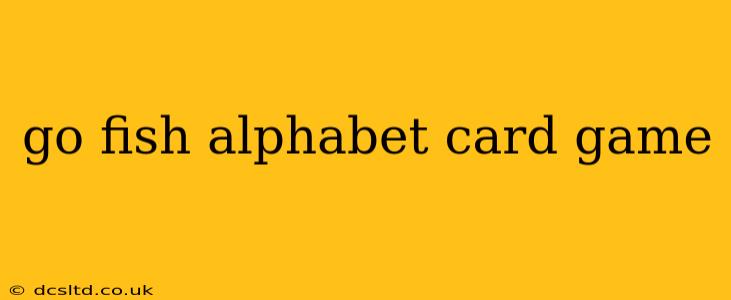Go Fish, a classic card game, is a fantastic tool for teaching children the alphabet. This article explores how to adapt the game for alphabet learning, focusing on variations and benefits for different age groups. We'll also delve into frequently asked questions parents often have about this educational twist on a beloved pastime.
How to Play Go Fish: Alphabet Edition
The basic rules of Go Fish remain the same, but instead of matching numbers, players aim to match letters.
What you'll need:
- A standard deck of playing cards (remove Jokers) or create your own alphabet cards (26 cards, each with a different letter of the alphabet). Creating your own cards can be a fun activity in itself! Consider adding illustrations to the cards to make it even more engaging.
- At least two players
Gameplay:
- Deal the cards: Shuffle the cards and deal seven cards to each player. Place the remaining cards face down in the center – this is the "Go Fish" pile.
- Matching letters: Players look at their hands and try to find pairs of cards with the same letter. For example, two "A"s, two "B"s, and so on. Set aside any matching pairs.
- Asking for letters: Starting with the youngest player, each player takes turns asking another player for a specific letter. For instance, "Do you have any 'G's?"
- Giving letters: If the asked player has the requested letter, they must give all cards with that letter to the asker. The asker then sets aside any matching pairs they now possess.
- Go Fish! If the asked player doesn't have the requested letter, they say "Go Fish!" and the asker draws one card from the "Go Fish" pile. If the drawn card completes a pair, the player sets it aside.
- Game End: The game continues until all matching pairs have been found and the "Go Fish" pile is empty. The player with the most pairs wins!
Adapting the Game for Different Age Groups
Preschoolers (Ages 3-5):
- Simplified version: Use only a subset of the alphabet (A-M, for example), or focus on letters the child is already familiar with.
- Visual aids: Use cards with large, clear letters and colorful illustrations to help younger children recognize them.
- Focus on matching: The emphasis should be on the act of matching and recognizing letters, not necessarily on winning the game.
Elementary School (Ages 6-12):
- Full alphabet: Use the entire alphabet for a more challenging game.
- Variations: Introduce variations like requiring players to spell words with their letter pairs to add another layer of learning.
- Competitive element: Encourage friendly competition to maintain engagement.
Frequently Asked Questions (FAQs)
What are some alternative ways to create alphabet cards?
You can use index cards, construction paper, or even print out alphabet flashcards and laminate them for durability. Get creative! You could even use letter magnets on a cookie sheet.
Can I use this game to teach other skills besides the alphabet?
Absolutely! You can adapt the game to teach phonics, sight words, or even simple math concepts by changing the cards to reflect those skills.
How can I make the game more engaging for my child?
Use fun, colorful cards, offer small rewards for winning, or make the game a collaborative activity instead of a competitive one. Involving your child in creating the cards can also boost their engagement.
My child is struggling to learn their letters. How can this game help?
Repeated exposure to the letters through the game makes it a fun and engaging way to learn letter recognition. The hands-on nature of the game reinforces learning.
What are the benefits of using games like Go Fish for learning the alphabet?
Go Fish offers a fun, interactive way to learn the alphabet, fostering a positive attitude towards learning. It improves memory, enhances letter recognition skills, and encourages social interaction. The repetitive nature helps reinforce learning.
By adapting the classic Go Fish game to focus on the alphabet, you can create a fun and engaging learning experience for children of all ages. Remember to tailor the game to your child’s abilities and interests to maximize its educational benefits. Enjoy playing!
